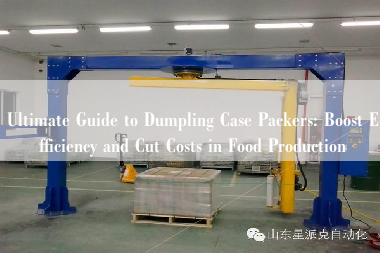1.1 Defining Dumpling Case Packers and Core Capabilities
A dumpling case packer is a specialized automation system designed for high-speed, sanitary placement of frozen or fresh dumplings into shipping cartons. Unlike generic case packers, these systems incorporate food-grade materials, temperature-resistant components, and precision handling mechanisms to protect delicate dumpling products. Core functions include:
– Gentle Product Handling: Vacuum grippers or soft belt conveyors prevent deformation
– Accurate Weight/Count Control: Integrated checkweighers or vision systems ensure portion consistency
– Seamless Upstream Integration: Synchronization with dumpling formers, steamers, or freezers
– Hygienic Design: Stainless steel construction with IP65 washdown protection
1.2 Operational Mechanics and Automation Levels
Dumpling case packing systems operate through a sequenced workflow:
- Infeed Orientation: Dumplings align uniformly via vibratory feeders or vision-guided robots
- Tray/Carton Formation: Cases erect automatically with adjustable guides for custom box sizes
- Precision Loading: Delta robots or pick-and-place arms deposit products in configured patterns
- Quality Verification: Sensors detect underfilled/overfilled cases before sealing
- Outfeed Handling: Packed cases transfer to case sealers or palletizers
Automation Gradients:
– Semi-Automatic: Manual case loading with automated product placement (30-50 cases/hr)
– Fully Automatic: Robotic case erecting-packing-sealing integration (80-200+ cases/hr)
– End-to-End Lines: Integrated with upstream dough sheeters and downstream robotic palletizers

1.3 Industry Applications and Operational Demands
Dumpling case packers serve critical functions across food manufacturing segments:
– Frozen Food Plants: High-volume packaging for retail-ready bags-in-box configurations
– Ethnic Food Producers: Handling diverse dumpling shapes (gyoza, pierogi, potstickers)
– Central Kitchens: Small-batch flexibility for regional specialty brands
– Export Facilities: Compliance with international cold-chain logistics standards
Prevailing Market Requirements:
– Throughput Scalability: 24/7 operation handling 5,000-20,000 dumplings/hour
– Sanitary Certification: NSF/3-A compliant components for allergen control
– Format Agility: Quick-change tooling for switching between wontons, bao, and dumplings
– Labor Reduction: Replacing 3-5 manual packing stations per line
2.1 Performance Advantages and Selection Framework
Automatic dumpling case packers deliver measurable operational improvements versus manual methods. Primary advantages include:
– Labor Reduction: Single automated unit replaces 3-5 manual packing stations
– Output Consistency: Maintain ±1% weight accuracy across 24/7 production cycles
– Product Integrity: Food-grade vacuum grippers eliminate dumpling damage during transfer
– Sanitary Compliance: NSF-certified stainless steel construction prevents bacterial harborage
Critical Selection Parameters:
– Throughput Requirements: Match machine speed (cases/hour) to upstream freezer capacity
– Format Flexibility: Verify quick-change tooling compatibility with dumpling varieties (gyoza, bao)
– Integration Capability: Ensure PLC compatibility with existing case erectors and sealers
– Hygiene Certification: Require documented IP65 washdown and allergen control protocols
2.2 Cost Analysis and Investment Factors
Dumpling case packer pricing reflects technical specifications and operational scope:
Price Determinants
| Factor | Semi-Automatic Range | Fully Automatic Range |
|——–|———————-|———————-|
| Base Configuration | $45,000–$75,000 | $110,000–$220,000 |
| Custom Tooling | +$8,000–$15,000 | +$15,000–$40,000 |
| Vision Systems | N/A | +$20,000–$35,000 |
| Installation | $5,000–$10,000 | $15,000–$30,000 |
Total Cost of Ownership Considerations
– Energy Consumption: Fully robotic systems average 15-22 kW/hour during operation
– Maintenance Costs: Annual servicing equals 3-5% of initial equipment investment
– Changeover Losses: Format switches without quick-change features incur $120–$300/hour downtime
– ROI Timeline: Most facilities achieve payback in 14-22 months through labor reduction
2.3 Procurement Strategy and Operational Insights
Proven Selection Methodology
1. Conduct video validation tests using actual dumpling samples
2. Audit supplier’s food safety documentation (HACCP, SQF support)
3. Verify spare parts availability for critical components (grippers, sensors)
4. Require 24/7 remote diagnostics capability
Frequent Buyer Questions
– Can one machine handle both fresh and frozen dumplings?
Temperature-rated models (-40°C to 50°C) manage state transitions with anti-condensation heaters.
-
What floor space is required?
Compact footprints start at 3.2m × 2.1m; end-to-end lines need 8m × 4m. -
How are irregular shapes accommodated?
Adjustable guide rails and programmable delta robots adapt to potsticker folds. -
What sanitation intervals are necessary?
Daily wet cleaning requires 45 minutes; full deep cleaning weekly.
